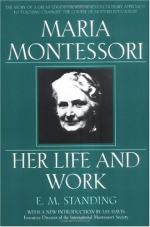
|
| Name: _________________________ | Period: ___________________ |
This test consists of 15 multiple choice questions and 5 short answer questions.
Multiple Choice Questions
1. Why did Montessori suggests that the animal instinct to walk at birth is gone in humans?
(a) Infants are too pampered.
(b) It is unnecessary.
(c) We have digressed as a species.
(d) We have the opportunity to create our movement.
2. What was one thing Montessori would telling her international training courses about teaching?
(a) Teach learning.
(b) Teach discipline.
(c) Teach a formatted curriculum.
(d) Teach teaching.
3. What does a teacher in a traditional school, being tied to a curriculum experience each day?
(a) Similar planned activities each day.
(b) Order.
(c) Defined progress.
(d) Boredom.
4. What type of interaction occurs in the Montessori classroom?
(a) Child-Environment.
(b) Teacher-Child-Environment.
(c) Teacher-Child.
(d) Teacher-Environment.
5. What simile about children is used by both Montessori and Froebel?
(a) Open books.
(b) Soft wax.
(c) Willing learners.
(d) Blank slates.
6. According to Montessori, what must a a teacher do in order to no longer look at herself as someone with a duty to push children forward?
(a) Admit defeat.
(b) Know all the answers.
(c) Understand the child.
(d) Become humble.
7. According to Montessori, what are the two sins that will distort the true vision of a child?
(a) Anger and a mean spirit.
(b) Selfishness and anger.
(c) Pride and selfishness.
(d) Pride and anger.
8. What type of interaction occurs in a traditional classroom?
(a) Teacher-Environment.
(b) Child-Environemnt.
(c) Teacher-Child.
(d) Teacher-Child-Envorinment.
9. According to Standing, what do both the Montessori and the Froebel methods have a great affinity to produce?
(a) Unity.
(b) Peace.
(c) Accomplishment.
(d) Encouragement.
10. Who defined man as the rational animal?
(a) Aristotle.
(b) Socrates.
(c) Jung.
(d) Plato.
11. What did Montessori emphasize in terms of activity methods?
(a) Understanding theories.
(b) Doing things correctly.
(c) Remaining engaged.
(d) Precision, order, and discipline.
12. According to Montessori, what can be said about the adults feeling of oppressing their children?
(a) They do not care.
(b) It is intentional.
(c) They feel it is necessary.
(d) It is not intentional.
13. How does Standing state Froebelians view the Montessori method?
(a) Perfect.
(b) Too unstructured.
(c) Too rigid.
(d) Too vague.
14. According to Montessori, what does it take for movement to be perfected?
(a) Disciplined study.
(b) Lots of play time.
(c) Involunatry effort.
(d) Voluntary effort.
15. Where did Montessori state the imagination is derived from?
(a) At home.
(b) The internal world.
(c) The external world.
(d) The classroom.
Short Answer Questions
1. What occurs when children learn a task at the right period of their learning, or sensitive time?
2. In the Montessori classroom, what must be distributed evenly to foster the child?
3. What does the Montessori method try to encourage concerning silence?
4. According to Montessori, what must be constructed before the individual can begin his movements?
5. In "The Fundamental Problem & Prepared Environment," what type of food, does Standing state a child might prefer over a $500 ornate lunch?
|
This section contains 479 words (approx. 2 pages at 300 words per page) |

|




